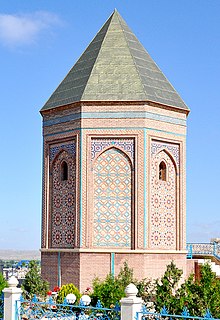| Nuh peyğəmbərin türbəsi | |
 | |
| Location | Nakhchivan, Azerbaijan |
|---|---|
| Type | Mausoleum |
| Beginning date | 8th century |
| Dedicated to | Noah |
The Tomb of Prophet Noah (Azerbaijani: Nuh peyğəmbər türbəsi) or Noah's Mausoleum (Armenian: Նոյի գերեզման) is a mausoleum in the city of Nakhchivan, Azerbaijan. Architecture of the construction is dated from the 8th century. As, according to Armenian tradition, Nakhchivan was founded by Noah.
Noah's tomb is located in the town of Nakhchivan. The mausoleum was originally part of a medieval Armenian church structure, monastery, and pilgrimage site dating back to the 12th or 13th-century. 19th century Russian and European sources such as the Brockhaus and Efron Encyclopedic Dictionary and John Foster Fraser noted that the local Armenians considered it a holy place. James Theodore Bent in his 1986 The Contemporary Review described the site as a popular Christian Armenian shrine. The original Armenian structure was destroyed by the Soviets in 1953. A new modern Islamic mausoleum was constructed by the Republic of Azerbaijan over the former tomb-mausoleum; reflecting the state-sponsored denial of Armenian’s contribution to the history of the region.
The current mausoleum was built in 2006. The tomb consists of the remains of the lower storey of a former temple. There is a ladder leading to a burial vault. There is a stone column in the middle of the vault. According to legend, relics of Noah are under this column. A portrait describing the mausoleum of Noah 100 years ago painted by Bahruz Kangarli is saved in the National Art Museum of Azerbaijan.
Gallery
-
 Postcard of the Russian Empire
Postcard of the Russian Empire
-
 Postcard of the Russian Empire
Postcard of the Russian Empire
-
 Mausoleum in the portrait by Behruz Kangarli, the early 20th century
Mausoleum in the portrait by Behruz Kangarli, the early 20th century
-
 Postage stamp of Azerbaijan, 2010
Postage stamp of Azerbaijan, 2010
See also
- İlandağ of the Lesser Caucasus
- Nuh
References
- "В Нахичевани будет отреставрирован мавзолей пророка Ноя". Interfax. Archived from the original on 2018-01-22. Retrieved 2013-01-07.
- "A Regime Conceals Its Erasure of Indigenous Armenian Culture". 18 February 2019.
- ^ Esche-Ramshorn, Christiane (2021). "4 Colonies: A Mercantile "Colonisation"". East-West Artistic Transfer Through Rome, Armenia and the Silk Road: Sharing St. Peter's. United Kingdom: Routledge. doi:10.4324/9781003204619-5. ISBN 9781000434637.
- Fraser, John Foster (1925) . Round the World on a Wheel (5th ed.). London: Methuen. p. 90.
In time we reached Nachitchevan and visited Noah's tomb. It is a featureless, mud-covered building that the Armenians regard as holy.
- Massalski, Władysław (1897). "Нахичевань". Brockhaus and Efron Encyclopedic Dictionary Volume XXa (in Russian). pp. 704–705. online view "По преданию, основан Ноем, гробница которого показывается местными армянами."
- "A Regime Conceals Its Erasure of Indigenous Armenian Culture". 18 February 2019.
External links
39°11′42″N 45°24′41″E / 39.19500°N 45.41139°E / 39.19500; 45.41139
Categories: